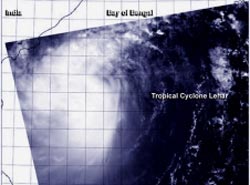NASA Watches as India Braces for Tropical Cyclone Lehar

The MODIS instrument aboard NASA's Aqua satellite captured this visible image of Tropical Cyclone Lehar nearing the coast of central India on Nov. 27 at 0715 UTC. <br>Image Credit: NRL-Monterey/NASA<br>
Warnings were in effect in India for northern Andhra Pradesh and southern Odisha as Lehar approaches. Lehar will bring winds, heavy rainfall and storm surge to those Indian states today, and tomorrow. A storm surge of up to 3 meters is possible.
The MODIS instrument aboard NASA's Aqua satellite captured a visible image of Tropical Cyclone Lehar nearing the coast of central India on Nov. 27 at 0715 UTC/2:15 a.m. EST. The MODIS image showed bands of thunderstorms extending from the northern and southern quadrants of the storm, wrapping into the center. There was no visible eye, despite Lehar being at minimal hurricane-strength.
At 1500 UTC/10 a.m. EST on November 27, Lehar's maximum sustained winds were near 55 knots/63.2 mph/101.9 kph. Tropical-storm-force winds extended out 105 nautical miles/120.8 miles/194.5 km from the center of circulation, and the center was about 195 nautical miles southeast of Visakhapatnam, India. That puts the center near 15.1 north and 84.2 east. Lehar is generating high and rough seas with wave heights to 24 feet/7.3 meters as it moves to the west-northwest at 12 knots/13.8 mph/22.2 kph.
The Joint Typhoon Warning Center expects Lehar to strengthen a little more before making landfall in eastern India on November 27 at 0700 UTC/2 a.m. EST. By November 28 Lehar is expected to dissipate.
Text credit: Rob Gutro
NASA's Goddard Space Flight Center
Media Contact
All latest news from the category: Earth Sciences
Earth Sciences (also referred to as Geosciences), which deals with basic issues surrounding our planet, plays a vital role in the area of energy and raw materials supply.
Earth Sciences comprises subjects such as geology, geography, geological informatics, paleontology, mineralogy, petrography, crystallography, geophysics, geodesy, glaciology, cartography, photogrammetry, meteorology and seismology, early-warning systems, earthquake research and polar research.
Newest articles

Detector for continuously monitoring toxic gases
The material could be made as a thin coating to analyze air quality in industrial or home settings over time. Most systems used to detect toxic gases in industrial or…

On the way for an active agent against hepatitis E
In order to infect an organ, viruses need the help of the host cells. “An effective approach is therefore to identify targets in the host that can be manipulated by…

A second chance for new antibiotic agent
Significant attempts 20 years ago… The study focused on the protein peptide deformylase (PDF). Involved in protein maturation processes in cells, PDF is essential for the survival of bacteria. However,…





















